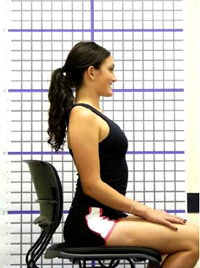Posture testing can be useful for identifying and correcting postural deviations, and for prescribing exercise to correct posture or which is appropriate for a particular posture type. Postural deviations may be a result of muscle imbalances and lightness and weakness of particular joints and muscles. The method described is to used grid placed behind the subject.
purpose: to assess posture using a simple method.
equipment required: posture assessment grid (or similar wall with markings), camera (optional)
procedure: Shoes should be removed and minimal clothing worn. The subject stands in set distance in front of a posture grid, in a natural and relaxed stance. Using a camera to capture the image makes for easier analysis, though the assessment can also be done visually without a photo. The body alignment is checked against the horizontal or vertical lines. Check the alignment of the head, neck, spine, shoulders, hips, legs, ankles etc. Repeat the assessment to compare the participant's front, side and back posture.
results: this assessment can reveal a stiff or hypermobile spine, tight muscles, kyphosis, lordosis, scoliosis/spinal curvature, rounded shoulders, hyperextended joints, and an array of other alignment issues.
comments:
- Keep the procedure standard in case you wish to repeat the procedure in future to assess changes in posture.
- The posture grid can also be used for range-of-motion (flexibility) measurements.
Similar Tests
Related Pages
- Posture grid products
- Posture, Biomechanics & Their Relationship to Injuries
- Flexibility testing
- Other Health Related Tests
- Sports Biomechanics
- Other Health Tests, including more on posture assessment.


 Current Events
Current Events